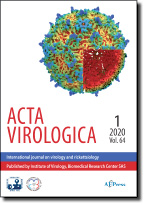Acta Virologica Vol.55, No.2, p.107-115, 2011
|
| Title: Identification and functional studies of HLA-A0201 restricted CTL epitopes
in the X protein of hepatitis B virus |
| Author: Y. J. GUO, Y. ZHU, S. H. SUN |
|
Abstract: Cytotoxic T lymphocyte (CTL) epitopes in the X protein (HBx) of hepatitis B virus (HBV) may play a key role in the viral control and liver damage. The aim of this study was to identify and study the function of HLA-A0201 restricted CTL epitopes in HBx of HBV genotypes B and C that are epidemic in China. Four nonapeptides signed HBx1: VLCLRPVGA, HBx2: CLFKDWEEL, HBx3: VLHKRTLGL, and HBx4: HLSLRGLPV were predicated by computational analysis and manually confirmed by defining the peptide supermotif, extended motif, and quantitative motif. Synthesized peptides were examined for their affinity and binding stability with HLA-A0201. After being analyzed by enzyme-linked immunospot (ELISPOT) and cytolytic activity assays, the HBx2 epitope was selected for a construction of HLA-A0201-peptide tetramers. The tetramer staining method was used to analyze peripheral blood mononuclear cells (PBMCs) isolated from HBV-infected patients at different disease stages (chronic hepatitis, liver cirrhosis, and hepatoma). Compared with CTL epitopes in the HBV envelope or polymerase, HBx2 is also a potential HLA-A0201 restricted CTL epitope, what may have a clinical implication.
|
|
| Keywords: hepatitis B virus; HLA-A0201 antigen; T-cell epitope; cytotoxic T lymphocyte |
|
|
|
| Year: 2011, Volume: 55, Issue: 2 |
Page From: 107, Page To: 115 |
doi:10.4149/av_2011_02_107
|
Price:
18.00 €
|
|
|
|
|
|
|
|

